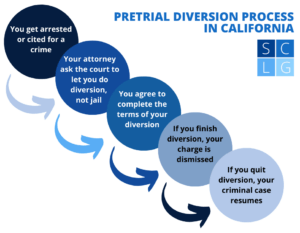A pretrial diversion program is an alternative resolution of a criminal case by which you can avoid jail and a criminal conviction. The program diverts you out of the criminal justice system and into a form of supervised release or probation.
If you complete the diversion program, you can have your case dismissed. If you fail the program, you are prosecuted for the original offense.

What is a pretrial diversion program?
Pretrial diversion programs are a different way to resolve a criminal case.
Normally, you:
- are arrested,
- are charged with a crime, and
- either plead guilty and get sentenced, or plead not guilty and go to trial.
Pretrial diversion programs remove you from this process between the arrest and the trial. Some programs become options after the charges have been filed, but before trial. Others become available before you are even charged.
These programs aim to lighten the strain on local courts by diverting low-level, non-violent offenses. They also provide rehabilitation services to the people who could use them the most. If you are unlikely to run afoul of the law, diversion allows you to move on from your mistake without a potentially devastating criminal conviction or arrest record.
Different states and even different counties or cities have different diversion programs available. Many locales have multiple programs available for different offenses. Some examples include diversion programs specifically for:
- drug possession, especially possession of marijuana,
- shoplifting,
- driving under the influence (DUI), and
- domestic violence.
What does the program entail?
While each is different, pretrial diversion programs focus heavily on rehabilitation and restitution services tailored to the alleged criminal offense.
For example, the pretrial diversion programs used for drug offenses often involve:
- completing a drug rehabilitation or substance abuse program,
- undergoing drug testing and passing random drug tests during the program,
- providing regular status updates to the court or to a program officer, and
- maintaining stable employment or status as a full-time student.
DUI diversion programs, on the other hand, often entail:
- paying restitution to the victim, if the arrest followed an accident,
- completing an alcohol rehabilitation course,
- driving with an ignition interlock device in the car, and
- passing a driver safety course.
Nearly all of these pretrial intervention programs also require you to:
- avoid being arrested or charged with another crime for a certain period,
- comply with any restraining orders in effect,
- pay all required program fees, and
- complete a certain number of community service hours.
Many of these elements are also used in probation programs. Pretrial diversion programs are often administered by the same state or county office that handles probation programs.
What offenders are eligible for diversion?
Many pretrial diversion programs will only accept you if you have no prior convictions or a fairly clean criminal record. Some programs, though, are more lenient in who can join. Many have eligibility requirements, but allow judges to make exceptions if you have a criminal history but seem like you would benefit more from the program than from a normal adjudication of your case.
Nearly all pretrial diversion programs require a finding that you are not a threat to public safety, though. This is why you are rarely eligible for a diversion program if you have been accused of a violent offense.
What criminal offenses are eligible?
Generally, diversion programs are for non-violent misdemeanors.
If the criminal charge is for a violent or a serious crime, like a felony offense, courts tend to think that it is too much of a risk to release you to a diversion program.

Many pretrial diversion programs involve counseling and treatment.
Do I have to plead guilty, first?
Some pretrial diversion programs require you to plead guilty to the criminal charges before you can be diverted from the criminal justice system. Other programs do not require a guilty plea.
The difference between these 2 types of programs is significant. If a diversion program requires a guilty plea, then it is a considerable risk to you. If you have legitimate defenses to the criminal charge, pleading guilty would waive those defenses. If you then fail to complete the terms of the program, their case would go back to court and straight to sentencing because you would have pleaded guilty, already. If the program does not require a guilty plea, if you fail the program then you would return to the criminal process in the same place as before.
Talking to a criminal defense attorney before deciding on taking a diversion program is very important. Having to plead guilty can drastically undermine your case.
What happens after completion of the program?
If you are eligible and choose to do a pretrial diversion program, successfully completing the program will usually mean that the charges will be dropped or the case dismissed. In some states, this is referred to as a “nolle prosequi,” Latin for an unwillingness to pursue the charges.
For programs that take you before charges were even filed, the prosecutor will drop the case when the diversion program is completed.
For programs that take you after charges were filed, but before the trial, the prosecutor will drop the charges. The judge will then dismiss the case.
If the program required a guilty plea, successfully completing the program can lead to:
- the judge changing the guilty plea to one of not guilty and then dismissing the case, or
- the judge ending the case and sealing the guilty plea through the expungement process.
What happens if I fail the program?
You will be returned to the court system if you participate in a pretrial diversion program but fail to complete it. The district attorney’s office will reopen the case. Law enforcement will resume prosecuting it.
If participating in the program required you to plead guilty, then the case returns to the criminal justice system at the sentencing phase. Because you pled guilty in order to participate in the diversion program, you will be unable to raise any legal defenses that you would have had.
Additional resources
Refer to the following for information about diversion programs in California’s biggest locales:

